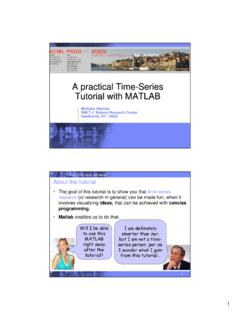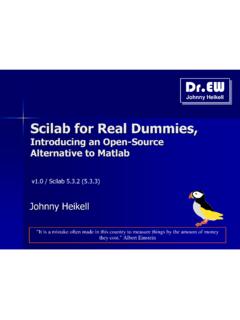Transcription of dSPACE and Real-Time Interface in Simulink
1 dSPACE and Real-Time Interface in Simulink Azad Ghaffari San Diego State University Department of ECE San Diego CA 92182-1309 12/20/2012 This document provides a tutorial introduction to the dSPACE software (ControlDesk Next Generation version ), the dSPACE DS1104 R&D controller board, and their use in development and implementation of maximum power point tracking (MPPT) for a single photovoltaic (PV) module using extremum seeking (ES) in Simulink software. It is intended for use as a quick-start guide to dSPACE hardware/software for a university course. Full details on the dSPACE hardware and software can be found in the dSPACE documentation. This presentation is prepared based on the following package: MATLAB Version (R2011a), Simulink Version (R2011a), and dSPACE DVD Release (2012).
2 1 dSPACE and Real-Time Interface in Simulink D e p a r t m e n t o f E l e c t r i c a l a n d C o m p u t e r E n g i n e e r i n g SDSU Contents 1. System Requirements .. 2 2. dSPACE Package .. 2 3. Real-Time and the Structure of a Real-Time Program .. 3 4. Photovoltaic Module and Maximum Power Point Tracking .. 4 5. Controller Design and Implementation in Simulink .. 7 Analog to Digital Conversion (ADC) and Signal Scaling .. 10 Digital to Analog Conversion (DAC) and Initialization 11 Building the Simulink Model .. 12 6. Control Desk Environment .. 14 7. How to Prepare the Tutorial Project .. 15 How to Measure Variable Values .. 17 8. Experimental Results.
3 20 9. References .. 21 2 dSPACE and Real-Time Interface in Simulink D e p a r t m e n t o f E l e c t r i c a l a n d C o m p u t e r E n g i n e e r i n g SDSU 1. System Requirements You can use an x86-compatible personal computer as a host PC for your dSPACE applications with following specifications: Host processor: Pentium 4 at 2 GHz (or equivalent) Main memory: 2 GB RAM or more (recommended) Disk space: GB on the program partition for complete installation of the DVD Dongle licenses: A USB port: To install the execution key (dongle) Required slots: To install a DS1104, you need one free 33 MHz/32-bit 5 V PCI slot ControlDesk Next Generation version which is a part of dSPACE DVD Release supports following operating system.
4 Windows XP Professional (32-bit version) with Service Pack 3 Windows Vista Business, Ultimate, and Enterprise (32-bit version) with Service Pack 2 Windows 7 Professional, Ultimate, and Enterprise (32-bit or 64-bit versions) with Service Pack 1 64-bit MATLAB versions are not supported. Real-Time Interface to Simulink which is a part of "RCP and HIL software" (Rapid Control Prototyping and Hardware-in the-Loop software) supports the following versions of MATLAB: R2012a, R2011b, R2011a, R2010bSP1, R2010a, R2009bSP1. 2. dSPACE Package To implement a Real-Time control loop using dSPACE and MATLAB we need following items. 1. dSPACE DS1104 R&D Controller Board 2. Dongle licenses on a USB flash disk 3 dSPACE and Real-Time Interface in Simulink D e p a r t m e n t o f E l e c t r i c a l a n d C o m p u t e r E n g i n e e r i n g SDSU 3.
5 File 4. file 5. Connector panel CP1104 3. Real-Time and the Structure of a Real-Time Program Suppose we have a continuous system and we want to control it with a discrete controller which has sampling time period of T. The following figure shows the connections between the system and its controller. We need analog-to-digital converters (ADC) to read the information of the sensors. Also to apply the control commands we need digital-to-analog converters (DAC). Fig. 1: Real-Time control structure Because this system or object has certain dynamics associated with it, you have to control it based on those dynamics. Therefore we say that the physical system will have a time constant, from which you will derive a step size or sample time for your control program.
6 The challenge is to not only use that sample time in the numerical calculations that make up your control algorithm, but also to execute that algorithm within that sample time . You have to start each step of your program exactly one sample time or step size apart, and thus have to finish the 4 dSPACE and Real-Time Interface in Simulink D e p a r t m e n t o f E l e c t r i c a l a n d C o m p u t e r E n g i n e e r i n g SDSU computation of each step within the sample time , before the next step starts. This is Real-Time . Please see the diagram below. : Real-Time control timing If the sample time of our program is T, you can see that the program is executed at distinct points in time that are one sample time apart.
7 You will also note that each step of the program finishes executing before the next step is due to start; thus this program is running in Real-Time . If however the computational demands of the program cause the processor to take more time than the sample time then we have an overrun condition, and our program cannot run in Real-Time . The overall structure of a Real-Time program can be simplified for explanation purposes into three main sections: Initialization, the Real-Time task or tasks, and the background. The initialization section is code that is executed only once at the start of execution, upon download of the program. In this section you will have functions that, for initialization of the system, are only needed to run once.
8 The next part of the program is the Real-Time part, the task, represented by the gray sections in the diagram above. This is what is executed periodically based on the sample time . This part is the heart of the control program; for this, you read inputs ( , from an ADC), compute your control signals, and write outputs ( , with a DAC). Note that depending on what your control application is you may have multiple tasks in your model. Finally, the last section is the background; this is code executed in the idle time between the end of computation of a step and the start of the next step. 4. Photovoltaic Module and Maximum Power Point Tracking The PV cell is modeled as an ideal current source of value i in parallel with an ideal diode with voltage v.
9 Electrical losses and contactor resistance are accounted for by the inclusion of the parallel and series resistances R and R , respectively. The amount of generated current i is dependent on the solar irradiance S and the temperature T. Fig. 3: PV module electrical equivalent circuit 5 dSPACE and Real-Time Interface in Simulink D e p a r t m e n t o f E l e c t r i c a l a n d C o m p u t e r E n g i n e e r i n g SDSU As is clear from following figure the power-voltage (P V) characteristic has a unique but (T, S) dependent peak. Fig. 4: Power and current variations of a PV module for different solar irradiance an environmental temperature It is the job of the MPPT algorithm to automatically track this peak.
10 In many grid-tied PV systems (including our current work), this is done by means of a separate DC/DC power electronics stage. Here we use a DC/DC buck converter as follows. Fig. 5: DC-DC Buck converter to harvest power from a PV module The averaged model of the buck converter in Continuous Conduction Mode (CCM) is described as v =v d 6 dSPACE and Real-Time Interface in Simulink D e p a r t m e n t o f E l e c t r i c a l a n d C o m p u t e r E n g i n e e r i n g SDSU where d is the pulse duration applied from pulse-width modulation unit to the gate of the switch. Variation of the power versus pulse duration for a PV module with P = 12W, = V, = 800 mA, = , and I = 700mA under standard test conditions is shown in the next figure.



